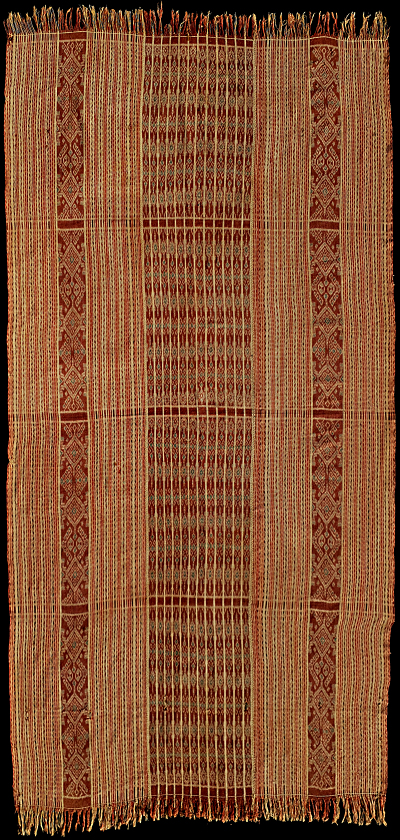| |
 
 | | | |
324 Timor, West Timor
Bete krao (men's wrap)  
| | Locale: | Manulea (Malaka Tengah), Atoin Meto people. | | Period: | 19th to early 20th c. | | Yarn: | Cotton, hand-spun, fine - plus pinstripes in commercial cotton | | Technique: | Warp ikat | | Panels: | 2 | | Size: | 115 x 230 cm (3' 9" x 7' 6") LW: 2.00 | | Design: | Two main ikat bands with chains of interlocking diamond-shaped patterns: two variants of the ubiquitous makaif motifs - which represent connection to the ancestors. Half of these were given heads, tails, and small feet, making clear that they represent crocodiles, widely seen as proto-ancestors. Numerous small accents in a slightly greenish pale indigo - a Manulea hallmark which helps to distinguish its ikat textiles from rather similar Biboki cloths. The decoration of the midfield is unusually rich for Manulea standards and supports early aging, as does the very irregular hand-spun cotton. | | Background: | Chapters on Timor and West Timor. | | Exhibited: | Timor: Totems and Tokens, Museu do Oriente, Lisbon, 2019/20. | | Published: | Timor: Totems and Tokens, 2019.
Ikat Textiles of Timor: Indonesian and Timor-Leste, 2025. | | Compare: | 224 150 | | Sources: | Crocodile motif very similar to those in Yeager and Jacobson, Textiles of Western Timor, Fig. 47k, 47l and particularly 47n, which was found on a 1937 Belu sarong depicted in Vroklage 1952, Vol. III. Similar to Manulea cloth on Plate 225, but with more intricate decoration. Similar main ikated motif on sarong from Insana in McIntosh, Thread and Fire, Fig. 8.13. | | |

©Peter ten Hoopen, 2025
All rights reserved.
|
|


